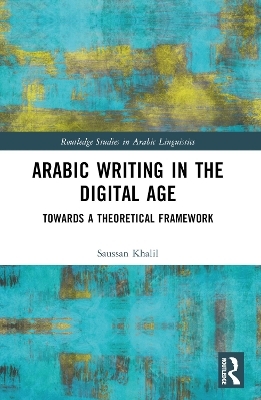
Arabic Writing in the Digital Age
Towards a Theoretical Framework
Seiten
2024
Routledge (Verlag)
978-0-367-49070-6 (ISBN)
Routledge (Verlag)
978-0-367-49070-6 (ISBN)
The written and spoken forms of Arabic have been traditionally viewed as separate forms of the language that rarely overlap in writing, but this book will examine the recently emerged concept of ‘mixed’ writing that combines both written and spoken forms.
This book takes a close look at different examples of mixed Arabic writing in modern (twentieth to twenty-firstt century) print and online literature, offering an analysis of this type of mixing alongside a dynamic model for analysing mixed Arabic writing, and the motivations for producing this type of writing. This book further introduces the ground-breaking concept of the seven writing styles for Arabic, ranging from Classical Arabic to ChatSpeak, whilst also offering an overview of early Arabic literacy and children’s literature.
Primarily aimed at Arabic researchers and teachers in linguistics, sociolinguistics, identity studies, politics and Teaching Arabic as a Foreign Language, this book would also be informative for undergraduate and postgraduate students studying Arabic as foreign language, Arabic linguistics and dialectology.
This book takes a close look at different examples of mixed Arabic writing in modern (twentieth to twenty-firstt century) print and online literature, offering an analysis of this type of mixing alongside a dynamic model for analysing mixed Arabic writing, and the motivations for producing this type of writing. This book further introduces the ground-breaking concept of the seven writing styles for Arabic, ranging from Classical Arabic to ChatSpeak, whilst also offering an overview of early Arabic literacy and children’s literature.
Primarily aimed at Arabic researchers and teachers in linguistics, sociolinguistics, identity studies, politics and Teaching Arabic as a Foreign Language, this book would also be informative for undergraduate and postgraduate students studying Arabic as foreign language, Arabic linguistics and dialectology.
Saussan Khalil, Senior Arabic Language Teacher, Faculty of Asian and Middle Eastern Studies, University of Cambridge, UK. Founder & Director, Kalamna CIC (www.kalamna.org).
Contents
List of Figures
Acknowledgements
Introduction
Variation in Arabic
A delineation of variation in Arabic
The proposed theoretical framework: seven writing styles
A practical application of the writing styles in online writing
Colloquial Written Arabic in print, in various dialects
Children’s literature and early literacy
Conclusion
Index
| Erscheinungsdatum | 03.05.2022 |
|---|---|
| Reihe/Serie | Routledge Studies in Arabic Linguistics |
| Zusatzinfo | 22 Tables, black and white; 10 Halftones, black and white; 10 Illustrations, black and white |
| Verlagsort | London |
| Sprache | englisch |
| Maße | 156 x 234 mm |
| Gewicht | 453 g |
| Themenwelt | Schulbuch / Wörterbuch ► Wörterbuch / Fremdsprachen |
| Geisteswissenschaften ► Sprach- / Literaturwissenschaft ► Anglistik / Amerikanistik | |
| Geisteswissenschaften ► Sprach- / Literaturwissenschaft ► Literaturwissenschaft | |
| Geisteswissenschaften ► Sprach- / Literaturwissenschaft ► Sprachwissenschaft | |
| ISBN-10 | 0-367-49070-6 / 0367490706 |
| ISBN-13 | 978-0-367-49070-6 / 9780367490706 |
| Zustand | Neuware |
| Informationen gemäß Produktsicherheitsverordnung (GPSR) | |
| Haben Sie eine Frage zum Produkt? |
Mehr entdecken
aus dem Bereich
aus dem Bereich
Poetik eines sozialen Urteils
Buch | Hardcover (2023)
De Gruyter (Verlag)
CHF 83,90
Buch | Softcover (2024)
belleville (Verlag)
CHF 27,95


